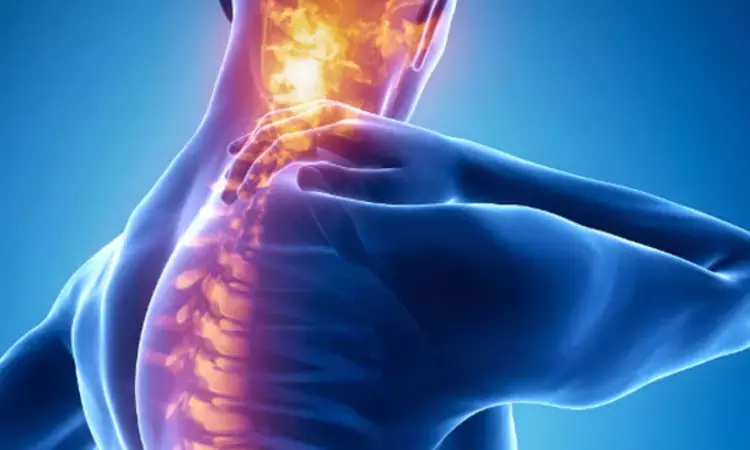- Home
- Medical news & Guidelines
- Anesthesiology
- Cardiology and CTVS
- Critical Care
- Dentistry
- Dermatology
- Diabetes and Endocrinology
- ENT
- Gastroenterology
- Medicine
- Nephrology
- Neurology
- Obstretics-Gynaecology
- Oncology
- Ophthalmology
- Orthopaedics
- Pediatrics-Neonatology
- Psychiatry
- Pulmonology
- Radiology
- Surgery
- Urology
- Laboratory Medicine
- Diet
- Nursing
- Paramedical
- Physiotherapy
- Health news
- Fact Check
- Bone Health Fact Check
- Brain Health Fact Check
- Cancer Related Fact Check
- Child Care Fact Check
- Dental and oral health fact check
- Diabetes and metabolic health fact check
- Diet and Nutrition Fact Check
- Eye and ENT Care Fact Check
- Fitness fact check
- Gut health fact check
- Heart health fact check
- Kidney health fact check
- Medical education fact check
- Men's health fact check
- Respiratory fact check
- Skin and hair care fact check
- Vaccine and Immunization fact check
- Women's health fact check
- AYUSH
- State News
- Andaman and Nicobar Islands
- Andhra Pradesh
- Arunachal Pradesh
- Assam
- Bihar
- Chandigarh
- Chattisgarh
- Dadra and Nagar Haveli
- Daman and Diu
- Delhi
- Goa
- Gujarat
- Haryana
- Himachal Pradesh
- Jammu & Kashmir
- Jharkhand
- Karnataka
- Kerala
- Ladakh
- Lakshadweep
- Madhya Pradesh
- Maharashtra
- Manipur
- Meghalaya
- Mizoram
- Nagaland
- Odisha
- Puducherry
- Punjab
- Rajasthan
- Sikkim
- Tamil Nadu
- Telangana
- Tripura
- Uttar Pradesh
- Uttrakhand
- West Bengal
- Medical Education
- Industry
Neuropathic Pain in Type 1 Diabetes: High Incidence Without Clinical Signs and Limited Relief from Medications, Study

USA: Recent findings underscore a critical issue in managing Type 1 Diabetes (T1D): the high prevalence of neuropathic pain (NP), which often occurs without overt clinical signs of neuropathy. This emerging concern highlights the need for more effective strategies for diagnosing and managing this condition.
"The incidence of NP in T1D was notably high, often occurring without detectable clinical signs of neuropathy as measured by the Michigan Neuropathy Screening Instrument (MNSI). Additionally, the observed relief from pain could not be attributed to using pain medications," the researchers wrote in Diabetes Care.
While diabetic peripheral neuropathy (DPN) is a well-recognized complication, the specific characteristics and impact of neuropathic pain (NP) in Type 1 Diabetes remain insufficiently understood. Barbara H. Braffett, Biostatistics Center, The George Washington University, Rockville, MD, and colleagues aimed to assess the initial incidence, annual prevalence, remission rates, and risk factors associated with neuropathic pain over an extended follow-up period in individuals with T1D.
For this purpose, the researchers administered the MNSI annually from 1994 to 2020 to 1,324 participants in the Epidemiology of Diabetes Interventions and Complications (EDIC) study. Neuropathic pain was categorized into two groups: NP with clinical signs of diabetic peripheral neuropathy (NP DPN+), defined as self-reported NP along with an MNSI examination score greater than 2, and NP without clinical signs of diabetic peripheral neuropathy (NP DPN−), defined as self-reported NP with an MNSI score of 2 or less.
The study revealed the following findings:
- At EDIC year 1, the median age for participants was 36 years, diabetes duration 13 years, and HbA1c 7.9%.
- At year 26, the cumulative incidence of NP was 57%, regardless of concomitant clinical signs of DPN (36% NP DPN+ vs. 46% NP DPN−).
- NP prevalence was 20% at 26 years (11% NP DPN+ and 9% NP DPN−), suggesting frequent remission.
- Annualized remission rates were similar regardless of pain medication use. In addition to HbA1c, female sex was associated with NP DPN−.
This study emphasized the critical need for screening for neuropathic pain (NP) even in the absence of objective signs of neuropathy during examinations, facilitating earlier and more effective management. It also underscored the significance of rigorous diabetes control in preventing both neuropathy and NP. Furthermore, the research revealed that the progression of NP is not influenced by NP medication use, potentially helping to minimize the reliance on multiple medications in patient care.
"The findings indicate that neuropathic pain in Type 1 Diabetes was prevalent and often occurred even without clinical signs of neuropathy. Notably, pain remission could not be attributed to the use of medication. Additionally, neuropathic pain was linked to higher HbA1c levels and was more common in females," the researchers concluded.
Reference:
Barbara H. Braffett, Laure El ghormli, James W. Albers, Eva L. Feldman, William H. Herman, Rose A. Gubitosi-Klug, Catherine L. Martin, Trevor J. Orchard, Neil H. White, John M. Lachin, Bruce A. Perkins, Rodica Pop-Busui, DCCT/EDIC Research Group; Neuropathic Pain With and Without Diabetic Peripheral Neuropathy in Type 1 Diabetes. Diabetes Care 27 August 2024; 47 (9): 1559–1567. https://doi.org/10.2337/dc23-1749
Dr Kamal Kant Kohli-MBBS, DTCD- a chest specialist with more than 30 years of practice and a flair for writing clinical articles, Dr Kamal Kant Kohli joined Medical Dialogues as a Chief Editor of Medical News. Besides writing articles, as an editor, he proofreads and verifies all the medical content published on Medical Dialogues including those coming from journals, studies,medical conferences,guidelines etc. Email: drkohli@medicaldialogues.in. Contact no. 011-43720751


